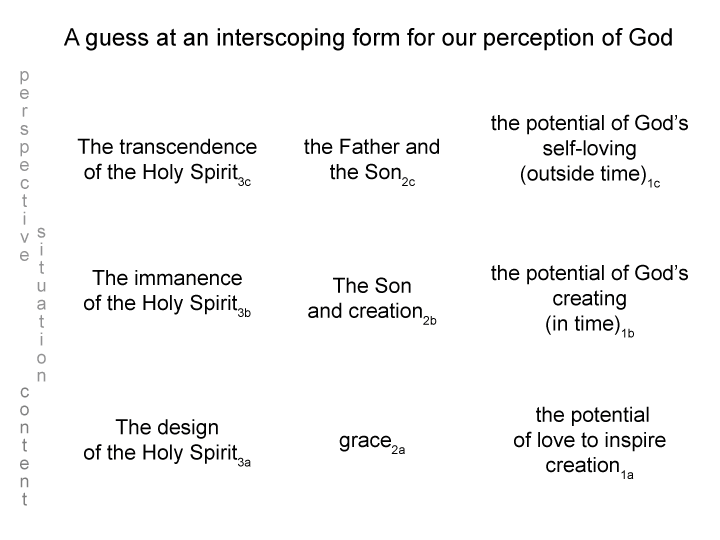Man and Sin by Piet Schoonenberg (1964) 2.2 BY-2
[I am not sure what the answer is.
Is Grace somehow related to the design of Creation?
No human can own it. No human lives without it.]
Man and Sin by Piet Schoonenberg (1964) 2.2 BY-1
[Who knows?
Maybe, grace is an actuality on the adjacent lower level to Creation. That would produce a complete interscope, containing the following virtual nested form in the category of actuality:
Father and Son2c( Creation2b( Grace2a))]
Man and Sin by Piet Schoonenberg (1964) 2.2 BX
[The Creation belongs to a nested form that accompanies ‘God Recognizing Himself’.
God Recognizing Himself accounts for Creation.
This is how actuality works. Secondness is dyadic.
Yet…
…As soon as I acknowledge the dyad in objectrel2cC, it transforms into an interscope.]
Man and Sin by Piet Schoonenberg (1964) 2.2 BW
[But here is a problem:
Humans evolved to recognize and participate in normal contexts and possibilities (in addition to actualities). We process actuality in terms of the nested form.
Consequently, the dyad within the monotheistic objectrelation2cC is experienced as a pair of nested forms.]
Man and Sin by Piet Schoonenberg (1964) 2.2 BV
[‘Grace’ is not What the Father Recognizes.
‘Grace’ is not the Son, the Object of the Father’s Love and Recognition.
‘Grace’ is like the dynamic of their Love and Recognition. This dynamic belongs to Creation because ‘the possibility of Creation’ synchronizes with ‘the Potential of God Recognizing Himself’.
Perhaps, the theological One True Triune God may be regarded as ‘a relation outside of time (eternal and archetypal)’ even as it engenders, by belonging to the realm of actuality, ‘another relation inside of time (immanent and conditional)’.]
Man and Sin by Piet Schoonenberg (1964) 2.2 BU
[The nested form of the Triune God serves as the third model.
This model is open to further exploration.
Grace, like love, seems to belong to the design inherent in the normal context the Holy Spirit, who brings the Father and the Son into relation.
Grace also seems to belong to the Possibility of God’s Self-Recognition.
In this model, the word ‘grace’ points to ‘the bringing of actuality from the Possibility of God Recognizing Himself according to the Designs of the Holy Spirit’.
Yet, the word ‘grace’ differs from both ‘the Possibility of God Recognizing Himself’ and ‘the Designs of the Holy Spirit’.
‘Grace’ differs from both ‘the Foundation of Love’ and ‘Love’.
Yet, belongs to both.]
Man and Sin by Piet Schoonenberg (1964) 2.2 BT
[Model two is the intersection of participation and recognition.
The single actuality belonging to ‘the intersection of recognition (vertical axis) and participation (horizontal axis)’ is a state of existence.
Existence reflects either ‘grace’ or ‘self-destruction’.]
Man and Sin by Piet Schoonenberg (1964) 2.2 BS
[Grace becomes a hidden attractor under conditions of alienation, when an infrasovereign thinkgroup has gained sovereign power. In this case, the parallel vertical axes become thinkpro-object and thinkanti-object. Thinkdivine is forcibly veiled by thinkpro-object.
Here, grace calls from the outside. Whenever one turns away from the totalitarian system, one senses the attractor, thinkdivine, not as an idea, but more like a melody.
Consciencepro-object senses the possibility of consciencefree.]
Man and Sin by Piet Schoonenberg (1964) 2.2 BR
[Grace moves us under the normal conditions where thinkdivine and thinkgroup are exclusive and interpolating. Grace calls from the outside and the inside. One can entertain both consciencefree and consciencelacking at the same time. Conscience belongs to the realm of possibility.]

